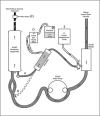Pediatric renal replacement therapy in the intensive care unit
- PMID: 23095413
- PMCID: PMC5545793
- DOI: 10.1159/000342129
Pediatric renal replacement therapy in the intensive care unit
Abstract
Renal replacement therapy (RRT) is used in a wide variety of pediatric populations. In this article, we will review the advantages and disadvantages of the different RRT modalities and the technical aspects of providing pediatric RRT. In addition, we will review the use of RRT with extracorporeal membrane oxygenation, the use of continuous RRT in the critically ill child with acute kidney injury and fluid overload, and the use of RRT for the removal of toxins and treatment of inborn errors of metabolism.
Copyright © 2012 S. Karger AG, Basel.
Figures



Similar articles
-
Fluid overload and fluid removal in pediatric patients on extracorporeal membrane oxygenation requiring continuous renal replacement therapy.Crit Care Med. 2012 Sep;40(9):2694-9. doi: 10.1097/CCM.0b013e318258ff01. Crit Care Med. 2012. PMID: 22743776 Free PMC article.
-
Extracorporeal pediatric renal replacement therapy: diversifying application beyond kidney failure.Pediatr Nephrol. 2025 Apr;40(4):923-932. doi: 10.1007/s00467-024-06533-z. Epub 2024 Oct 8. Pediatr Nephrol. 2025. PMID: 39375217 Free PMC article. Review.
-
Renal replacement therapy in critically ill patients receiving extracorporeal membrane oxygenation.Clin J Am Soc Nephrol. 2012 Aug;7(8):1328-36. doi: 10.2215/CJN.12731211. Epub 2012 Apr 12. Clin J Am Soc Nephrol. 2012. PMID: 22498496 Free PMC article. Review.
-
Continuous renal replacement therapy during extracorporeal membrane oxygenation in patients treated in medical intensive care unit: technical considerations.Ther Apher Dial. 2014 Dec;18(6):523-34. doi: 10.1111/1744-9987.12188. Epub 2014 Sep 4. Ther Apher Dial. 2014. PMID: 25195931 Review.
-
Extracorporeal organ support (ECOS) in critical illness and acute kidney injury: from native to artificial organ crosstalk.Intensive Care Med. 2018 Sep;44(9):1447-1459. doi: 10.1007/s00134-018-5329-z. Epub 2018 Jul 24. Intensive Care Med. 2018. PMID: 30043276 Review.
Cited by
-
Clinical Pharmacology Studies in Critically Ill Children.Pharm Res. 2017 Jan;34(1):7-24. doi: 10.1007/s11095-016-2033-y. Epub 2016 Sep 1. Pharm Res. 2017. PMID: 27585904 Free PMC article. Review.
-
Pharmacokinetics in Critically Ill Children with Acute Kidney Injury.Paediatr Drugs. 2023 Jul;25(4):425-442. doi: 10.1007/s40272-023-00572-z. Epub 2023 Jun 2. Paediatr Drugs. 2023. PMID: 37266815 Review.
-
Extracorporeal renal and liver support in pediatric acute liver failure.Pediatr Nephrol. 2021 May;36(5):1119-1128. doi: 10.1007/s00467-020-04613-4. Epub 2020 Jun 5. Pediatr Nephrol. 2021. PMID: 32500250 Review.
-
Prescription of CRRT: a pathway to optimize therapy.Ann Intensive Care. 2020 Mar 6;10(1):32. doi: 10.1186/s13613-020-0648-y. Ann Intensive Care. 2020. PMID: 32144519 Free PMC article. Review.
-
Kidney support for babies: building a comprehensive and integrated neonatal kidney support therapy program.Pediatr Nephrol. 2023 Jul;38(7):2043-2055. doi: 10.1007/s00467-022-05768-y. Epub 2022 Oct 13. Pediatr Nephrol. 2023. PMID: 36227440 Review.
References
-
- Chesney RW. The development of pediatric nephrology. Pediatr Res. 2002;52:770–778. - PubMed
-
- Schaefer F, Warady BA. Peritoneal dialysis in children with end-stage renal disease. Nat Rev Nephrol. 2011;7:659–668. - PubMed
-
- Zaritsky J, Warady BA. Peritoneal dialysis in infants and young children. Semin Nephrol. 2011;31:213–224. - PubMed
-
- Symons JM, Chua AN, Somers MJ, Baum MA, Bunchman TE, Benfield MR, Brophy PD, Blowey D, Fortenberry JD, Chand D, Flores FX, Hackbarth R, Alexander SR, Mahan J, McBryde KD, Goldstein SL. Demographic characteristics of pediatric continuous renal replacement therapy: a report of the prospective pediatric continuous renal replacement therapy registry. Clin J Am Soc Nephrol. 2007;2:732–738. - PubMed
-
- Fleming GM, Walters S, Goldstein SL, Alexander SR, Baum MA, Blowey DL, Bunchman TE, Chua AN, Fletcher SA, Flores FX, Fortenberry JD, Hackbarth R, McBryde K, Somers MJ, Symons JM, Brophy PD. Nonrenal indications for continuous renal replacement therapy: a report from the prospective pediatric continuous renal replacement therapy registry group. Pediatr Crit Care Med. 2012 E-pub ahead of print. - PubMed
Publication types
MeSH terms
Grants and funding
LinkOut - more resources
Full Text Sources

